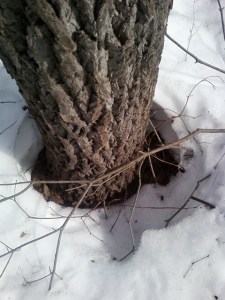I finally turned back.
Perhaps my plan was ill advised from the start. To run and hike in two feet of snow without the aid of snow shoes or skis. Or even boots. Just La Sportive Wildcat trail shoes and a plastic bag I had slipped over each of my feet before I put my shoes on. But I really thought the snow would have been tamped down already by other hikers with their snow shoes or cross country skis or boots.
Apparently very few people had been out and the trail was covered with thick pillowy snow, softening in the warming temperatures. But on I ran, counting on my Kahtoola Microspikes to grab the ice and hard packed snow and prevent slipping. They were no match for today’s conditions. In some cases I crashed through the top layer of hard packed snow. But in other spots I post holed, my foot slipping into a cauldron of cold. After thirty minutes I finally accepted that I was neither trail running nor hiking, but rather slowly and inefficiently slogging my way uncomfortably through a forest blanketed in snow.
It was time to retreat, that moment when hope collides with reality.
Mountaineers must deal with the quandary of retreat. If a mountaineer advances to a summit when the odds are against her, she risks her life. Yet if she retreats she will have spent thousand of dollars and weeks or months on an unsuccessful expedition. Successful climbers, however, succeed in part because they know when to advance and when to retreat.
American mountaineer Ed Visteurs, the first U.S. climber to ascend all of the world’s 14 peaks over 8,000 meters (and without the use of supplemental oxygen), offered realistic advice about success in mountain climbing. “Getting to the top is optional. Getting down is mandatory”, he said. Each person who sets out on an adventure, be it large or small, must respect his own limits, his own edge of ability.
During my retreat I noticed that snow that had settled around the edge of the base of the trees was now melting away from those same trunks, leaving a ring of snow. And that ring forms a thin edge. The snow was disappearing gradually from around the trunks. The edge where the two had coexisted was the first spot to melt away.
Snow always begins its retreat at the edges, where it abuts a fencepost, or sidewalk or stone wall. The edge is a fragile place. Retreat for humans also occurs at the edge, the edge of ability or mental discipline. And when retreat comes, it starts with just one foot step, one step back. But that one step may be the difference between adventure and misadventure. When you are standing on the edge, knowing whether to walk forward or back is one of life’s great challenges. But do not mistake turning back for defeat. Retreat is simply an opportunity to try another day.
Howard E. Friedman


